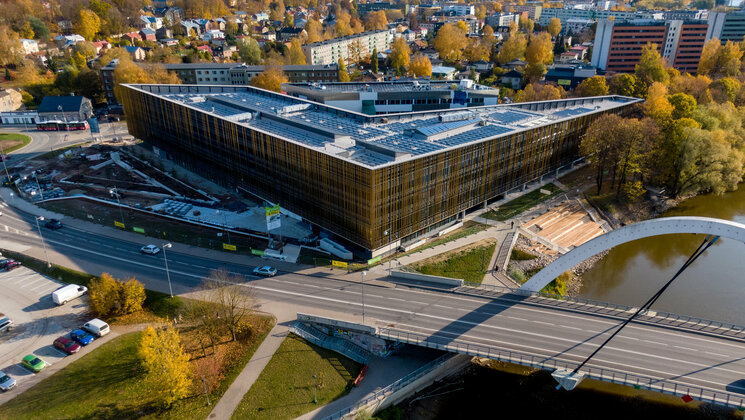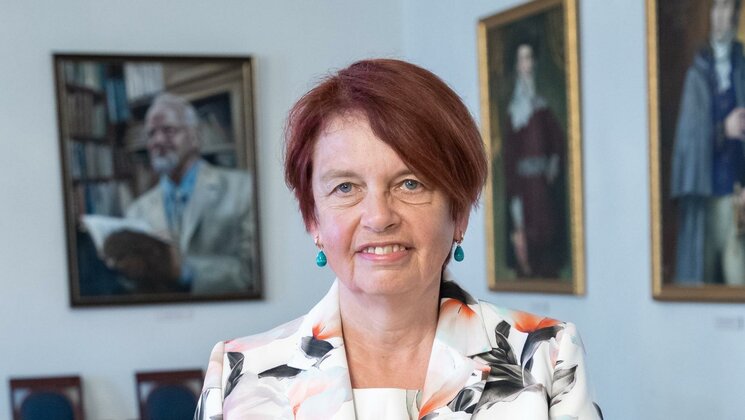-
Faculty of Arts and HumanitiesDean's Office, Faculty of Arts and HumanitiesJakobi 2, r 116-121 51005 Tartu linn, Tartu linn, Tartumaa EST0Institute of History and ArchaeologyJakobi 2 51005 Tartu linn, Tartu linn, Tartumaa EST0Institute of Estonian and General LinguisticsJakobi 2, IV korrus 51005 Tartu linn, Tartu linn, Tartumaa EST0Institute of Philosophy and SemioticsJakobi 2, III korrus, ruumid 302-337 51005 Tartu linn, Tartu linn, Tartumaa EST0Institute of Cultural ResearchÜlikooli 16 51003 Tartu linn, Tartu linn, Tartumaa EST0Institute of Foreign Languages and CulturesLossi 3 51003 Tartu linn, Tartu linn, Tartumaa EST0School of Theology and Religious StudiesÜlikooli 18 50090 Tartu linn, Tartu linn, Tartumaa EST0Viljandi Culture AcademyPosti 1 71004 Viljandi linn, Viljandimaa EST0Professors emeriti, Faculty of Arts and Humanities0Associate Professors emeriti, Faculty of Arts and Humanities0Faculty of Social SciencesDean's Office, Faculty of Social SciencesLossi 36 51003 Tartu linn, Tartu linn, Tartumaa EST0Institute of EducationJakobi 5 51005 Tartu linn, Tartu linn, Tartumaa EST0Johan Skytte Institute of Political StudiesLossi 36, ruum 301 51003 Tartu linn, Tartu linn, Tartumaa EST0School of Economics and Business AdministrationNarva mnt 18 51009 Tartu linn, Tartu linn, Tartumaa EST0Institute of PsychologyNäituse 2 50409 Tartu linn, Tartu linn, Tartumaa EST0School of LawNäituse 20 - 324 50409 Tartu linn, Tartu linn, Tartumaa EST0Institute of Social StudiesLossi 36 51003 Tartu linn, Tartu linn, Tartumaa EST0Narva CollegeRaekoja plats 2 20307 Narva linn, Ida-Virumaa EST0Pärnu CollegeRingi 35 80012 Pärnu linn, Pärnu linn, Pärnumaa EST0Professors emeriti, Faculty of Social Sciences0Associate Professors emeriti, Faculty of Social Sciences0Faculty of MedicineDean's Office, Faculty of MedicineRavila 19 50411 Tartu linn, Tartu linn, Tartumaa ESTInstitute of Biomedicine and Translational MedicineBiomeedikum, Ravila 19 50411 Tartu linn, Tartu linn, Tartumaa ESTInstitute of PharmacyNooruse 1 50411 Tartu linn, Tartu linn, Tartumaa ESTInstitute of DentistryL. Puusepa 1a 50406 Tartu linn, Tartu linn, Tartumaa ESTInstitute of Clinical MedicineL. Puusepa 8 50406 Tartu linn, Tartu linn, Tartumaa ESTInstitute of Family Medicine and Public HealthRavila 19 50411 Tartu linn, Tartu linn, Tartumaa ESTInstitute of Sport Sciences and PhysiotherapyUjula 4 51008 Tartu linn, Tartu linn, Tartumaa ESTProfessors emeriti, Faculty of Medicine0Associate Professors emeriti, Faculty of Medicine0Faculty of Science and TechnologyDean's Office, Faculty of Science and TechnologyVanemuise 46 - 208 51003 Tartu linn, Tartu linn, Tartumaa ESTInstitute of Computer ScienceNarva mnt 18 51009 Tartu linn, Tartu linn, Tartumaa ESTInstitute of GenomicsRiia 23b/2 51010 Tartu linn, Tartu linn, Tartumaa ESTEstonian Marine Institute0Institute of PhysicsInstitute of ChemistryRavila 14a 50411 Tartu linn, Tartu linn, Tartumaa EST0Institute of Mathematics and StatisticsNarva mnt 18 51009 Tartu linn, Tartu linn, Tartumaa EST0Institute of Molecular and Cell BiologyRiia 23, 23b - 134 51010 Tartu linn, Tartu linn, Tartumaa ESTTartu ObservatoryObservatooriumi 1 61602 Tõravere alevik, Nõo vald, Tartumaa EST0Institute of TechnologyNooruse 1 50411 Tartu linn, Tartu linn, Tartumaa ESTInstitute of Ecology and Earth SciencesJ. Liivi tn 2 50409 Tartu linn, Tartu linn, Tartumaa ESTProfessors emeriti, Faculty of Science and Technology0Associate Professors emeriti, Faculty of Science and Technology0Institute of BioengineeringArea of Academic SecretaryHuman Resources OfficeUppsala 6, Lossi 36 51003 Tartu linn, Tartu linn, Tartumaa EST0Area of Head of FinanceFinance Office0Area of Director of AdministrationInformation Technology Office0Administrative OfficeÜlikooli 17 (III korrus) 51005 Tartu linn, Tartu linn, Tartumaa EST0Estates Office0Marketing and Communication OfficeÜlikooli 18, ruumid 102, 104, 209, 210 50090 Tartu linn, Tartu linn, Tartumaa EST0Area of Vice Rector for DevelopmentCentre for Entrepreneurship and InnovationNarva mnt 18 51009 Tartu linn, Tartu linn, Tartumaa EST0University of Tartu Natural History Museum and Botanical GardenVanemuise 46 51003 Tartu linn, Tartu linn, Tartumaa EST0International Cooperation and Protocol Office0University of Tartu MuseumLossi 25 51003 Tartu linn, Tartu linn, Tartumaa EST0Area of RectorRector's Strategy OfficeInternal Audit OfficeArea of Vice Rector for Academic AffairsOffice of Academic AffairsUniversity of Tartu Youth AcademyUppsala 10 51003 Tartu linn, Tartu linn, Tartumaa EST0Student Union OfficeÜlikooli 18b 51005 Tartu linn, Tartu linn, Tartumaa EST0Centre for Learning and TeachingArea of Vice Rector for ResearchUniversity of Tartu LibraryW. Struve 1 50091 Tartu linn, Tartu linn, Tartumaa EST0Grant Office
A talk by Osamu Shimmi, Professor of Developmental Biology, on intracellular signals
The inaugural lecture by Osamu Shimmi, Professor of Developmental Biology at the University of Tartu, is entitled “Cellular dynamics and signalling in tissue development: lessons from the fruit fly Drosophila melanogaster” and will take place at 16:15 on Thursday 17 October in the University Assembly Hall. The lecture will be given in English.
Animal development from embryo to adulthood involves dynamic changes in tissue structure. Studies have shown that it is mediated by a limited number of signalling proteins inherent to animals. A signalling protein is a molecule that acts in a cell as a kind of trigger, activating a chain of reactions. Despite increasing knowledge of tissue morphogenesis, i.e. its formation and development, it remains poorly understood how dynamic tissue structure affects signal transduction.
In his lecture, Professor Shimmi will introduce a hypothesis suggesting that it is indeed intrinsic cellular signals which regulate the size, shape and type of cells in tissue development. He will also talk about recent findings on how changes in cellular structure impact tissue architecture and how research into the fruit fly leads to further understanding of both human development and human diseases.
Tambet Tõnissoo, Head of Chair and Associate Professor in Developmental Biology, said that the correct formation of the shape of an organism and the shapes of individual body parts is both one of the most crucial and one of the most complicated components of animal development. “During morphogenesis, cells migrate to their correct locations, communicating with other cells, exchanging information with their ambient environment, changing their shape and behaviour and dividing,” he explained.
In his scientific research, Professor Shimmi focuses on tissue morphogenesis and signalling in the fruit fly Drosophila melanogaster. According to Tambet Tõnissoo, Professor Shimmi has elegantly demonstrated how tissue morphogenesis happens in fruit fly wing development due to regulation by signal molecules inherent to animal organisms. “The developmental model of the wing of the fruit fly, which can easily be genetically modified, is quite remarkable, because knowledge of the mechanisms of morphogenesis helps us to unravel the mechanisms underlying many human diseases that involve disturbances in normal morphogenesis,” he said.
Professor Shimmi earned his PhD in biochemistry at the University of Tsukuba, Japan and was a postdoctoral fellow at the Howard Hughes Medical Institute, University of Minnesota, USA. Since 2005 he has been a group leader with the Developmental Biology programme at the Institute of Biotechnology at the University of Helsinki. He has been a member of the Centre of Excellence in Experimental and Computational Developmental Biology of the Academy of Finland since 2014.
The inaugural lecture will be livestreamed and can be followed via the UTTV video portal.
For further information please contact:
Osamu Shimmi, Professor of Developmental Biology, University of Tartu, +358 440 456 765, osamu.shimmi@ut.ee
Tambet Tõnissoo, Head of Chair, Associate Professor in Developmental Biology, University of Tartu, +372 737 5025, tambet.tonissoo@ut.ee
Mob: +(372) 5307 7820
Read more similar news






